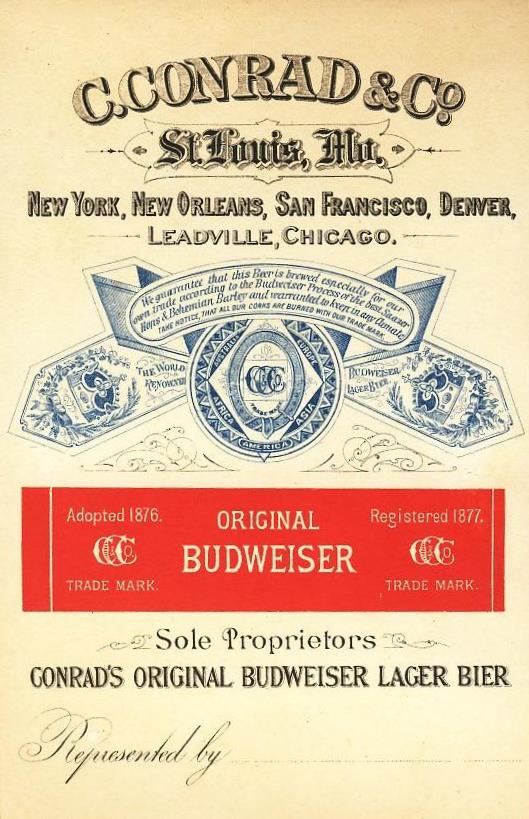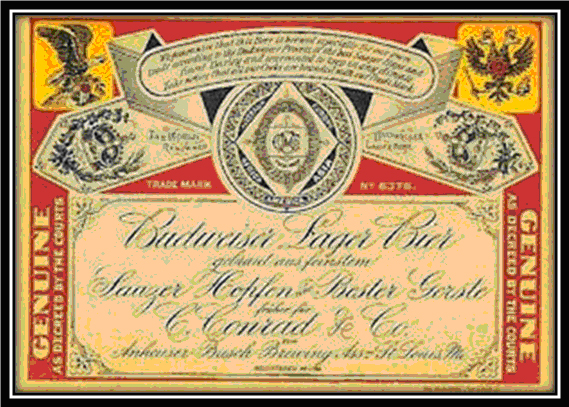This post is "History vs. The Budweiser 2017 Super Bowl Commercial."
So, let's get to it. For me, I love the Budweiser ads with their famous Clydesdale horses. And yes, I look forward to what Bud can come up with. It's always something to look forward to at each Super Bowl. This Super Bowl, I gather we won't be seeing any Clydesdales.
This year, maybe because the parent corporation of Bud is located where the European Union resides, Budweiser has decided make a statement regarding immigration and illegal alien policies here in the United States. They are doing so by running an ad about one of the founders of the American version of Budweiser.
Eberhard Anheuser was born on September 27th, 1806 and died on May 2nd, 1880. For Anheuser, his involvement in brewing beer all started in 1852 when fellow German American George Schneider, who was a brewer and saloon operator, opened the Bavarian Brewery Company in South St. Louis.
So what about Adolphus Busch, the young man who is the center of the you ask?
His wealthy family was known for running a wholesale business of winery and brewery supplies. Adolphus Busch and his brothers all were said to have received quality educations, and he graduated from the notable Collegiate Institute of Belgium in Brussels.
First, to answer why I say, "here in the United States."
That is because the company we know as Anheuser-Busch, aka Budweiser, is actually a foreign company owned by a Belgian/Brazilian multi-national corporation known as Anheuser-Busch InBev SA/NV. It's global headquarters is in Leuven, Belgium.
Yes, it's the same foreign multi-national corporation that now owns Miller, Foster's, and Labatt Brewing Companies, among others. So no, our Budweiser and Miller are no longer domestically owned beers.
Second, the reason that I say, "the American version of Budweiser."
Anheuser–Busch has been involved in a trademark dispute with a beer company known as Budweiser Budvar Brewery in the Czech Republic since 1907. Yes, all over the trademark rights to the name "Budweiser".
In the European Union, excluding Ireland, Finland and Spain, as you can see in the above image, the American Budweiser beer is marketed as "Bud" because the "Budweiser" trademark name is solely owned by Budweiser Budvar of the Czech Republic.
So why is the name "Budweiser" so important you ask?
Budweiser beer has been brewed in the city of "Ceske Budejovice," which in German means "Budweis," since it was founded by King Ottokar II of Bohemia in 1245. The name "Budweiser" supposedly means "of Budweis".
Budweiser Budvar has been brewing beer in accordance with the 1516 Reinheitsgebot law, using water, barley and hops. Budweiser Bier Bürgerbräu was founded in 1795 by German-speaking citizens of Budweis. It's slogan as the "Beer of Kings" sounds so familiar.
Budweiser Bier Bürgerbräu actually began exporting beer under the "Budweiser Bier" name to the United States in 1875. Yes, a year before Carl Conrad developed a "Bohemian-style" lager that he called "Budweiser" in 1876.
So now I'm sure you're asking, "Where does Tom come up with this stuff, and who the Hell is Carl Conrad?"
Well, he was the creator of the American version of Budweiser that we know today. And no, he wasn't a beer maker!
Carl W. Conrad was born on April 1st, 1843, and died on October 26th, 1922. Among beer historians, Conrad is believed to be the person who created the name "Budweiser" which would later belong to Anheuser-Busch.
Conrad marketed the beer we know as "Budweiser" which later became the property of Anheuser-Busch.
According to research, Conrad was a friend of the wealthy Busch family of Germany. He's credited with helping to develop the recipe for Budweiser beer. The brand name was first registered in the U.S. by Conrad, an importer of wines, champagnes & liquors.
The Anheuser Brewery produced the brand for him under contract. C. Conrad & Company. Conrad is said to have had offices in Germany and in St. Louis, Missouri.
Ever wonder about Anheuser of Anheuser-Busch fame?
Well, his story has everything to do with the huge German migration to St. Louis Missouri in the early 1800s. and how one person's failure can be another's gain.
Schneider hit paydirt and even expanded it just four years later in 1856 to include a new brewhouse nearby. But the following years were different as Schneider was forced to sell the brewery, all while on the brink of bankruptcy.
In 1860, Schneider's Bavarian Brewery was purchased by William D'Oench, a local pharmacist, and Eberhard Anheuser, a prosperous German-born soap manufacturer. Yes, Eberhard Anheuser was a German American soap and candle maker.
Anheuser was a soap manufacturer that lent money to the Bavarian Brewery. When the small brewery went bankrupt, Anheuser bought out the other creditors and renamed the company Anheuser.
It is said that D'Oench was a silent partner in the Bavarian Brewery until 1869. That's when he sold out his half-interest in the company. I'll tell you who he sold it to in a minute.
From 1860 to 1875, the Bavarian Brewery was renamed to E. Anheuser & Co.. Then from 1875 to 1879, it was renamed again as E. Anheuser Company's Brewing Association. Remember, they were still supplying beer to Carl Conrad's Budweiser beer company at that time.
So what about Adolphus Busch, the young man who is the center of the you ask?
Adolphus Busch was born on July 10th, 1839, and died on October 10th, 1913. And as stated earlier, Adolphus Busch came from a very wealthy German family. And while it was a very wealthy family, it was also a very large family. So large that Adolphus was the twenty-first of twenty-two children.
In 1857, at the age of 18, with three of his older brothers, Adolphus emigrated to St. Louis, Missouri. And no, they did not arrive in St. Louis by accident.
In the mid-1880s, St. Louis, Missouri was of the number one destination for German immigrants. Immigrants from Ireland and Germany arrived in St. Louis in huge numbers starting back in the 1840s.
The population of St. Louis grew from less than 20,000 in 1840, to 77,860 in 1850. And by 1860, to more than 160,000. It is said that by the mid-1800s, St. Louis had a bigger population than New Orleans. And because St. Louis was the new home to thousands of German and Irish immigrants, the market for beer in St. Louis was huge.
Besides that, the city also had two natural resources essential for manufacturing and storing beer before refrigeration. The Mississippi River provided more than enough of the needed water supply to make beer, while the city itself had many underground caves that were used to keep beer cool.
While everyone knows about Adolphus Busch through Anheuser-Busch Brewing fame, his older brother Johann established a brewery in Washington, Missouri. And yes, his other older brother Ulrich, Jr, married a daughter of Eberhard Anheuser in St. Louis and settled in Chicago. The third older brother who he came with was Anton, and he was a hops dealer but later returned to Germany.
Unlike his older brothers who were all in the beer brewery business in some way, Adolphus Busch's first job in St. Louis was working as a clerk in the commission house. Yes, as a city employee.
He then became an employee at William Hainrichshofen's wholesale company. Then he enlisted in the Union Army during the Civil War and served for six months. During this period, he learned that his father had died and he had inherited a portion of the estate.
With his inheritance Adolphus Busch partnered with Ernst Battenberg in St. Louis to found the first of his businesses, a brewing supply company that sold to the three dozen breweries in St. Louis. Eberhard Anheuser was one of Adolphus' customers.
Adolphus married Eberhard Anheuser's daughter, Lilly in 1861. He then entered his wife's family's brewery business. And yes, with the money from his inheritance and his business with Battenberg, Adolphus Busch bought out Eberhard's partner, William D'Oench.
That's how the E. Anheuser Company's Brewing Association became Anheuser-Busch in 1879. Then in 1880, at the death of Eberhard Anheuser, Adolphus Busch became president and instantly wealthy.
So contrary to what Anheuser-Busch InBev SA/NV tells us in their commercial, Adolphus Busch did not not come to an unfriendly America to get beat up and told to go back to where he came from.
While the end of their video says, "When nothing stops your dream, this is the beer we drink," this is a sorry re-write of a story of a young man who came here already with a lot going for himself. In fact, I'd say a tremendous amount more than most coming here.
The U.S. kept a lot of people out for various reasons during the 1800s. Most to have been affected were the Chinese and Catholics. To my knowledge, there wasn't any sort of anti-German protests at the time coming off the boat.
The U.S. kept a lot of people out for various reasons during the 1800s. Most to have been affected were the Chinese and Catholics. To my knowledge, there wasn't any sort of anti-German protests at the time coming off the boat.
Remember, Busch did not go through Ellis Island as an immigrant. Fact is, he had already been to the United States on a previous trip. In 1857, when he decided to live here, that was his second trip here.
After he left the first time, he loved it so much that he wanted to come back. He arrived here a wholesaler from a wealthy family. He immigrated to St. Louis from Germany in 1857 into an already heavily German population here. He came with three brothers and not alone as the commercial tries to depict. And yes, he married Eberhard Anheuser's daughter, Lilly, in 1861.
Then, following his service in the Union Army as a clerk, Busch began working as a salesman for his father-in-law at the Anheuser brewery. With his inheritance, he purchased 50% of the shares of the company in 1869. All by the age of 30.
Once he becomes half-owner, he assumes the role of company secretary. Then 11 years later at the age of 41, when his father-in-law dies in 1880, he then becomes president and even more wealthy. No, that's nothing like the commercial at all. And frankly, they should have incorporated some truth in their commercial.
Now for those of you who are wondering when did Anheuser-Busch Brewing Association actually acquire Carl Conrad’s company and the brand name "Budweiser"? It was in 1883. Although, it should be noted that Conrad did not actually sign over the trademark name of "Budweiser" to Anheuser-Busch until 1891.
Adolphus Busch, who was running the company by then, accepted the Budweiser trademark as payment of the debt. It is said that Conrad was given a lifetime job with Anheuser-Busch in sales.
By the 1880s, Carl Conrad’s Budweiser label was looking a lot like the Anheuser-Busch label it would become. And yes, the "CCCo" insignia and the name "C. Conrad & Co." remained in the center of their paper label until around 1920.





Lord take me downtown. I just wanna drink some Busch. LOL. Get it? That was a ZZ Top parody. That should be the next Busch Light commercial. I would pay to see that.
ReplyDelete